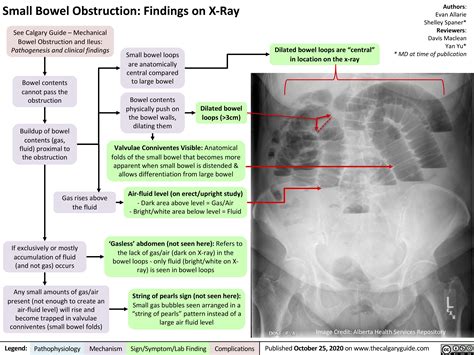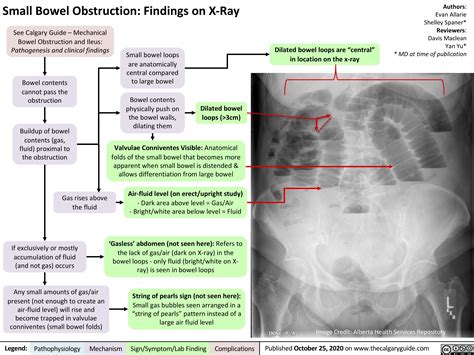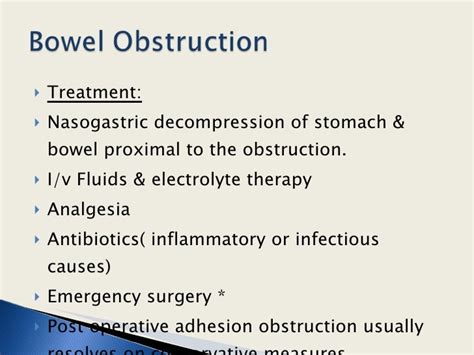Intro
Learn about small bowel obstruction symptoms, causes, and treatment. Identify signs like abdominal pain, vomiting, and constipation, and understand related conditions like intestinal blockage and bowel ischemia.
The small bowel, also known as the small intestine, plays a vital role in the digestive process. It is responsible for absorbing nutrients from the food we eat, which are then used to fuel the body. However, when the small bowel becomes obstructed, it can lead to a range of serious symptoms that can have a significant impact on a person's quality of life. Small bowel obstruction symptoms can be severe and even life-threatening if left untreated, making it essential to understand the warning signs and seek medical attention promptly.
Small bowel obstruction occurs when there is a blockage in the small intestine that prevents food, fluids, and gas from passing through. This blockage can be caused by a variety of factors, including adhesions, hernias, tumors, and intussusception. The symptoms of small bowel obstruction can vary depending on the severity and location of the blockage, but common signs include severe abdominal pain, nausea, vomiting, and constipation. In some cases, the obstruction can also lead to dehydration, electrolyte imbalances, and even perforation of the intestine, which can be fatal if not treated promptly.
Understanding the symptoms of small bowel obstruction is crucial for early detection and treatment. The sooner medical attention is sought, the better the chances of a successful outcome. In this article, we will delve into the world of small bowel obstruction symptoms, exploring the causes, signs, and treatment options available. Whether you are a patient, caregiver, or simply interested in learning more about this condition, this article aims to provide a comprehensive overview of small bowel obstruction symptoms and what to expect.
Causes of Small Bowel Obstruction

Common Causes of Small Bowel Obstruction
Some of the most common causes of small bowel obstruction include: * Adhesions: Scar tissue that forms between the intestine and other organs or the abdominal wall * Hernias: Protrusions of the intestine through a weakened area in the abdominal wall * Intussusception: Telescoping of one segment of the intestine into another * Tumors: Benign or malignant growths that can compress or invade the intestine * Volvulus: Twisting of the intestine, which can cut off blood supply and lead to ischemiaSymptoms of Small Bowel Obstruction

Early Warning Signs
It is essential to recognize the early warning signs of small bowel obstruction, which can include: * Mild abdominal pain or discomfort * Nausea or vomiting after eating * Constipation or diarrhea * Abdominal distension or bloating * Fatigue or lethargyDiagnosis of Small Bowel Obstruction

Imaging studies, such as X-rays, CT scans, and ultrasound, can help visualize the intestine and identify the location and severity of the obstruction. In some cases, a barium study or gastrografin enema may be performed to help diagnose the obstruction.
Imaging Studies
Some common imaging studies used to diagnose small bowel obstruction include: * X-rays: Can help identify air-fluid levels or free air under the diaphragm * CT scans: Can provide detailed images of the intestine and surrounding structures * Ultrasound: Can help identify intussusception or other causes of obstruction * Barium study: Can help visualize the intestine and identify the location of the obstruction * Gastrografin enema: Can help diagnose the obstruction and assess for perforationTreatment Options for Small Bowel Obstruction

Conservative Management
Conservative management of small bowel obstruction typically involves: * Bowel rest: Avoiding food and fluids to reduce intestinal activity * Fluids and electrolyte replacement: Replacing lost fluids and electrolytes to prevent dehydration and imbalances * Nasogastric suction: Removing stomach contents to reduce nausea and vomiting * Pain management: Controlling pain with medication to improve comfortSurgical Intervention
Surgical intervention may be necessary in cases where the obstruction is severe or the underlying cause requires surgical correction. Some common surgical procedures used to treat small bowel obstruction include: * Adhesiolysis: Removing adhesions that are causing the obstruction * Hernia repair: Repairing hernias that are causing the obstruction * Intussusception reduction: Reducing intussusception to relieve the obstruction * Tumor resection: Removing tumors that are causing the obstruction * Volvulus correction: Correcting volvulus to restore intestinal functionComplications of Small Bowel Obstruction

Preventing Complications
Preventing complications of small bowel obstruction requires prompt medical attention and treatment. It is essential to seek medical help immediately if symptoms persist or worsen over time. In addition, following a healthy diet, staying hydrated, and managing underlying medical conditions can help reduce the risk of complications.Living with Small Bowel Obstruction

Coping with Symptoms
Coping with symptoms of small bowel obstruction can be challenging, but there are several strategies that can help: * Keeping a symptom journal to track symptoms and identify patterns * Developing a bowel routine to manage constipation or diarrhea * Practicing stress-reducing techniques, such as meditation or deep breathing * Staying hydrated and managing electrolyte imbalances * Seeking support from family, friends, or support groupsWhat are the common causes of small bowel obstruction?
+Common causes of small bowel obstruction include adhesions, hernias, intussusception, tumors, and volvulus.
What are the symptoms of small bowel obstruction?
+Symptoms of small bowel obstruction include severe abdominal pain, nausea, vomiting, constipation, and abdominal tenderness.
How is small bowel obstruction diagnosed?
+Diagnosis of small bowel obstruction typically involves a combination of physical examination, laboratory tests, and imaging studies, such as X-rays, CT scans, and ultrasound.
What are the treatment options for small bowel obstruction?
+Treatment options for small bowel obstruction depend on the severity and location of the blockage, as well as the underlying cause, and may include conservative management or surgical intervention.
How can I prevent complications of small bowel obstruction?
+Preventing complications of small bowel obstruction requires prompt medical attention and treatment, as well as following a healthy diet, staying hydrated, and managing underlying medical conditions.
In conclusion, small bowel obstruction is a serious condition that requires prompt medical attention and treatment. By understanding the causes, symptoms, and treatment options available, individuals can take the first step towards managing their condition and improving their quality of life. If you or someone you know is experiencing symptoms of small bowel obstruction, do not hesitate to seek medical help. Share this article with others to raise awareness about this important topic, and take the first step towards a healthier and happier life.
